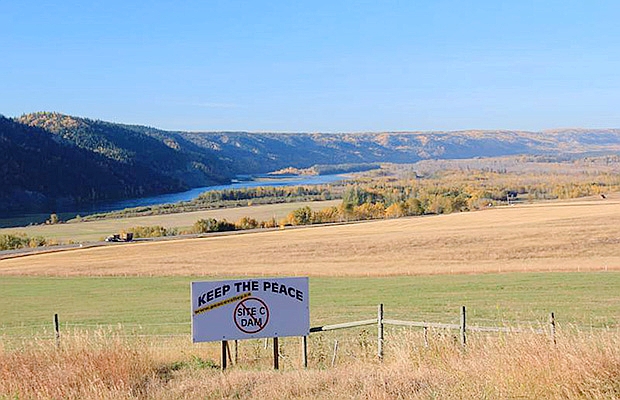First Nations are stating that the proposed Site C hydro-electric dam will lead to mercury contamination in fish.
To highlight this point, the West Moberly First Nation and the McLeod Lake Indian Band took large Bull trout contaminated with mercury to the British Columbia legislature in Victoria this week. The Canadian Press reports, “The fish were there to illustrate a recent study by the band that concluded 98 per cent of their fish samples contain mercury levels above provincial guidelines. The study examined 57 fish taken from the Crooked River, where fish migrate from the Williston Lake reservoir. [West Moberly First Nation Chief Roland] Willson said the contaminated Bull trout are connected to that reservoir, which was created as part of the 1960s-era W.A.C. Bennett dam.”
Site C would be a 60-metre high, 1,050-metre-long dam and hydroelectric generation station located on the Peace River between the communities of Hudson’s Hope and Taylor in northeastern British Columbia. It would create an 83-kilometre-long reservoir and flood about 5,550 hectares of agricultural land southwest of Fort St. John. It would submerge 78 First Nations heritage sites, including burial grounds and places of cultural and spiritual significance. Construction on Site C could begin this summer (if not stopped by a court injunction) and be completed by 2024.
In her critique of large dams, Council of Canadians chairperson Maude Barlow has written, “The drowning of land vegetation creates the habitat required by the bacteria that absorb any mercury that happens to be in the soil. The reservoirs convert this mercury into a form that fish can ingest and mercury then enters the food chain. It bioaccumulates, and can be many times more lethal by the time humans eat it than in its original form.”
The news article notes, “[Chief Willson] said area First Nations are preparing to embark on a human study to determine if people have high levels of mercury.”
Barlow has highlighted the relationship between dams and high levels of mercury in people. She has written, “When [the Cree of northern Quebec] ate fish from the waters diverted for the massive James Bay hydroelectric project, 64 percent of the Cree in the area took in unsafe levels of this poisonous element. Mercury poisoning can cause blindness, reproductive failure, and brain damage.”
Several Treaty 8 First Nations — the West Moberly, Doig River, Prophet River First Nations and McLeod Lake Indian Band — are attempting to stop Site C in court.
The Alaska Highway News reported this week that, “The latest attempt involves asking a judicial review to determine whether or not the decision to build the dam is legal. …B.C. Hydro’s Site C dam suffered a legal setback on [May 8] when a judge ruled against an attempt [by BC Hydro] to stop a judicial review from hearing certain aspects of their case. A Federal hearing on the matter is now set for the week of July 20. …[That hearing will hear arguments on] whether or not the [provincial] government should consider ‘the Site C project either on its own or in combination with the existing dams on the Peace River and the industrial developments in the northeast would be an infringement of their treaty rights.'”
Chief Willson has stated, “We have rights under our Treaty. They’re rights that cannot be infringed simply because a provincial utility wants more power. The recent Tsilhqot’in decision by the Supreme Court of Canada only bolsters governments’ obligations to accommodate our Aboriginal rights and title.”
The Council of Canadians has been opposing Site C for the past five years and supports the court challenge launched by the four First Nations.
Photo credit: Don Hoffmann



